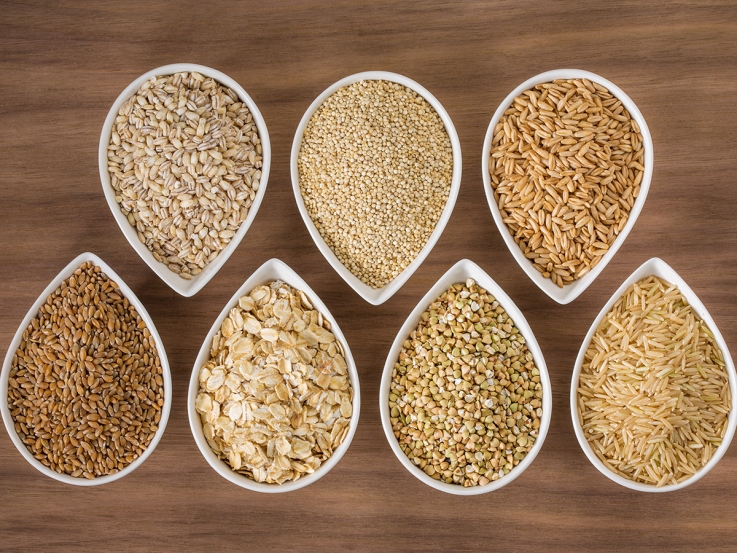Are whole grains good for you?
Low-carb diets have risen in popularity, but there are plenty of ways to eat for a healthy heart. Our review of the latest evidence shows that it’s the quality of carbohydrate that is most important.

Whole grains are best eaten in place of refined grains alongside plenty of vegetables and fruit.
What are intact whole grains?
Intact whole grains are unrefined and close to how they are found in nature such as oats, barley and brown rice. They contain a wide range of nutrients including fibre, vitamins, minerals and antioxidants, which are good for our hearts.
Examples of intact whole grains to eat most of:
- Whole oats
- Brown rice
- Barley
- Bulgar (cracked wheat)
- Quinoa
- Millet
- Buckwheat.
What are refined grains?
Refined grains are whole grains that are processed and are much less like they are found in nature, such as white bread, pasta and crackers. They contain fewer nutrients and less fibre and often contain added sugar, saturated fat and sodium.
Examples of refined grains – eat least of these
- White bread, rolls, wraps, flat breads etc.
- Crackers or crispbread
- White rice, pasta, couscous
- Puffed rice cereals and other low-fibre cereals
- White flour (and products i.e. bagels, pikelets, cakes, biscuits, donuts).
What are whole grain products?
Whole grain products have been through some processing but most of the nutritional benefits still remain, like whole grain bread and wholemeal flour.
Examples of whole grain products
- Wholemeal and mixed-grain breads, rolls, wraps
- Whole grain crackers, crispbread and oat cakes
- Wholemeal pasta
- Muesli
- Whole wheat biscuits
- Bran cereals
- Wheat bran, wheat germ
- Flours (i.e. wholemeal).

Are whole grains good for my heart?
Based on the findings from our ‘Whole grains and the heart’ review, eating whole grain foods can reduce your risk of heart disease by up to 30%.
When eaten as part of a heart-healthy diet, whole grains can help to:
- reduce cholesterol (total and low-density lipoprotein)
- reduce blood pressure
- reduce weight
- lower the risk of developing type 2 diabetes by up to 32%.
Whole grains may be most useful for people who need to lower their cholesterol or control their blood sugar levels.
On average, three servings of whole grains per day can help your heart to stay healthy and eating more than that is likely to be even better for your heart.
How can I eat more whole grains?
Are all whole grains healthy?
Not all whole grains are equal, unrefined grains with the natural fibre structure intact, are best for our bodies. In New Zealand, we get most of our whole grains from bread and breakfast cereals so it’s important to look for intact whole grains when choosing these foods.
Refined grains and some whole grain products, like crackers and breakfast cereals, can have sugar, salt and saturated fat added to them so the closer the product is to the original grain, the better.
Should I follow a low-carb diet?
Low-carb diets have increased in popularity. People on these diets usually don’t eat processed foods, sugar, refined grains and starchy foods (like bread, pasta, rice and potato). They may not eat legumes (like chickpeas and lentils) and certain fruit too.
There are plenty of ways to eat for a healthy heart, including eating carbohydrates. What’s most important is the quality of carbohydrate and food sources. Whole grains, fruit, starchy vegetables (like potato and taro) and legumes (like chickpeas and lentils), regardless of their carbohydrate content, can all be a part of a heart-healthy diet.
Most of us would be better off eating less refined and processed foods like white bread, biscuits and white pasta and eating more vegetables.
What does the Heart Foundation recommend?
The Heart Foundation recommends that all people in New Zealand, including those at risk of heart disease, replace refined grains with whole grains and high-fibre whole grain products.
- Where possible, choose intact whole grains that are close to how they are found in nature.
- If you choose to eat grains, focus on simple, affordable swaps from refined grains to whole grains or high–fibre whole grain products.
- Aim for at least three servings of whole grain foods per day for a healthy heart.
Adult serving size examples:
- ½ cup cooked porridge
- 1/3 cup natural muesli
- 1/3 cup brown rice (cooked)
- 2 whole wheat biscuits
- 3 wholemeal crispbreads
- 1 slice whole grain bread
- ½ whole grain bread roll.
Focus on the quality of whole grain foods rather than getting hung up on the quantity or serving sizes. If meals are based around whole grains, plenty of vegetables (half of the plate), legumes, nuts, seeds, oily fish and reduced-fat dairy, the nutrients will look after themselves.







